Product Images Gabapentin
View Photos of Packaging, Labels & Appearance
- image - d3fd11fe 4d3f 4002 8f9e 42cc12b4252d 01
- image - d3fd11fe 4d3f 4002 8f9e 42cc12b4252d 03
- image - d3fd11fe 4d3f 4002 8f9e 42cc12b4252d 04
- image - d3fd11fe 4d3f 4002 8f9e 42cc12b4252d 05
- image - d3fd11fe 4d3f 4002 8f9e 42cc12b4252d 06
- image - d3fd11fe 4d3f 4002 8f9e 42cc12b4252d 07
- image - d3fd11fe 4d3f 4002 8f9e 42cc12b4252d 08
- image - d3fd11fe 4d3f 4002 8f9e 42cc12b4252d 09
- image - d3fd11fe 4d3f 4002 8f9e 42cc12b4252d 10
- image - d3fd11fe 4d3f 4002 8f9e 42cc12b4252d 11
- image - d3fd11fe 4d3f 4002 8f9e 42cc12b4252d 12
- Label Image - lbl713350073
Product Label Images
The following 12 images provide visual information about the product associated with Gabapentin NDC 71335-0073 by Bryant Ranch Prepack, such as packaging, labeling, and the appearance of the drug itself. This resource could be helpful for medical professionals, pharmacists, and patients seeking to verify medication information and ensure they have the correct product.
image - d3fd11fe 4d3f 4002 8f9e 42cc12b4252d 01
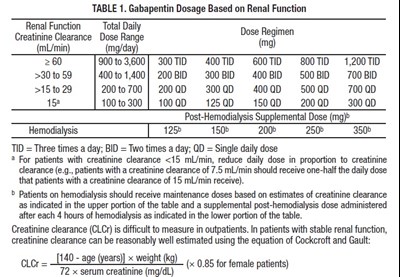
This is a dosage table for gabapentin based on renal function. There are different dose ranges based on creatinine clearance, with the highest dose being 1,200 mg three times a day for those with a creatinine clearance of over 60 mL/min and the lowest dose being 100 mg once a day for those on post-hemodialysis. The table also specifies supplemental post-hemodialysis doses for patients on hemodialysis. The table includes dosage regimens for BID, TID, and QD (two times a day, three times a day, and single daily dose, respectively). The estimated creatinine clearance can be obtained using the Cockcroft and Gault equation.*
image - d3fd11fe 4d3f 4002 8f9e 42cc12b4252d 03
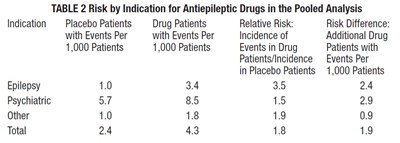
This text presents a table showing the risk of antiepileptic drugs in relation to different indications (epilepsy, psychiatric, and other). The table includes the number of patients with adverse events per 1,000 patients for both placebo and drug groups, along with the relative risk and risk difference.*
image - d3fd11fe 4d3f 4002 8f9e 42cc12b4252d 04
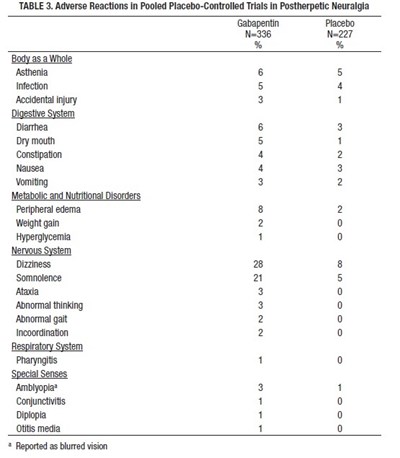
This table displays adverse reactions observed in pooled placebo-controlled trials in patients with Postherpetic Neuralgia who were treated with Gabapentin. The table compares the incidence of these reactions in patients treated with Gabapentin versus placebo. The adverse reactions are categorized by body system, and the percentage of patients who reported each reaction is provided for each group. The adverse reactions observed include: asthenia, infection, accidental injury, diarrhea, dry mouth, constipation, nausea, vomiting, peripheral edema, weight gain, hyperglycemia, dizziness, somnolence, ataxia, abnormal thinking, abnormal gait, incoordination, pharyngitis, amblyopia, conjunctivitis, diplopia, and otitis media. Blurred vision is noted to be reported as an adverse effect of Gabapentin.*
image - d3fd11fe 4d3f 4002 8f9e 42cc12b4252d 05
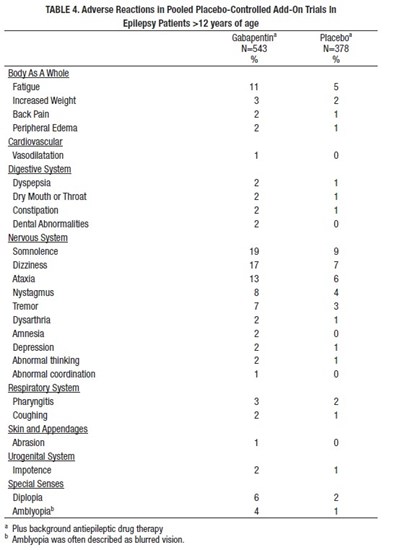
This is a table presenting the adverse reactions observed in pooled placebo-controlled trials of Gabapentin in epilepsy patients above 12 years of age. The table shows the percentage of patients experiencing various adverse reactions such as fatigue, increased weight, back pain, peripheral edema, dyspepsia, somnolence, dizziness, ataxia, nystagmus, tremor, dysarthria, amnesia, depression, abnormal thinking, abnormal coordination, amongst others. Some adverse reactions were observed in a higher percentage of Gabapentin patients compared to placebo patients. There is a note that amblyopia was often described as blurred vision.*
image - d3fd11fe 4d3f 4002 8f9e 42cc12b4252d 06
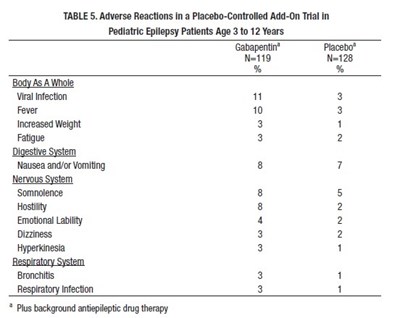
This is a table showing the adverse reactions of a placebo-controlled add-on trial in pediatric epilepsy patients aged 3 to 12 years who were administered Gabapentin or a placebo. Adverse reactions experienced by patients such as body aches, viral infections, fever, increased weight, fatigue, nausea, vomiting, somnolence, hostility, emotional liability, dizziness, hyperkinesia, bronchitis, or respiratory infection are listed in the table along with the percentage of patients who reported them.*
image - d3fd11fe 4d3f 4002 8f9e 42cc12b4252d 08

This is a table presenting information about controlled PHN studies, including the duration of each study, dosages of Gabapentin administered to patients, and the number of patients who received Gabapentin and those who received a placebo. The text specifies that the Gabapentin was given in three divided doses per day.*
image - d3fd11fe 4d3f 4002 8f9e 42cc12b4252d 11

The text appears to display statistical data from two controlled PHN studies. The figures show the proportion of patients who responded to treatment with greater than 50% reduction in pain score. The statistical significance of the proportion is displayed as p<0.001, indicating a high level of confidence. However, without additional context or variable definitions, it is not possible to draw further conclusions from this data. The last line of text shows three values (GEP 3600, GBP 1800, and GBP 2400), which are not clearly related to the rest of the information.*
Label Image - lbl713350073
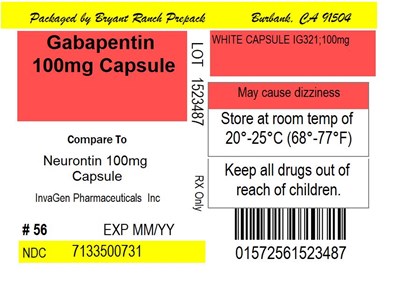
This is a medication label for Neurontin 100mg capsule packaged by Bryant Ranck Prepack. The medication is manufactured by InvaGen Pharmaceuticals Inc and has an expiration date of MM/YY. The National Drug Code (NDC) is 7133500731. The medication should be stored at room temperature (20°-25°C or 68°-77°F) and kept away from children.*
* The product label images have been analyzed using a combination of traditional computing and machine learning techniques. It should be noted that the descriptions provided may not be entirely accurate as they are experimental in nature. Use the information in this page at your own discretion and risk.



